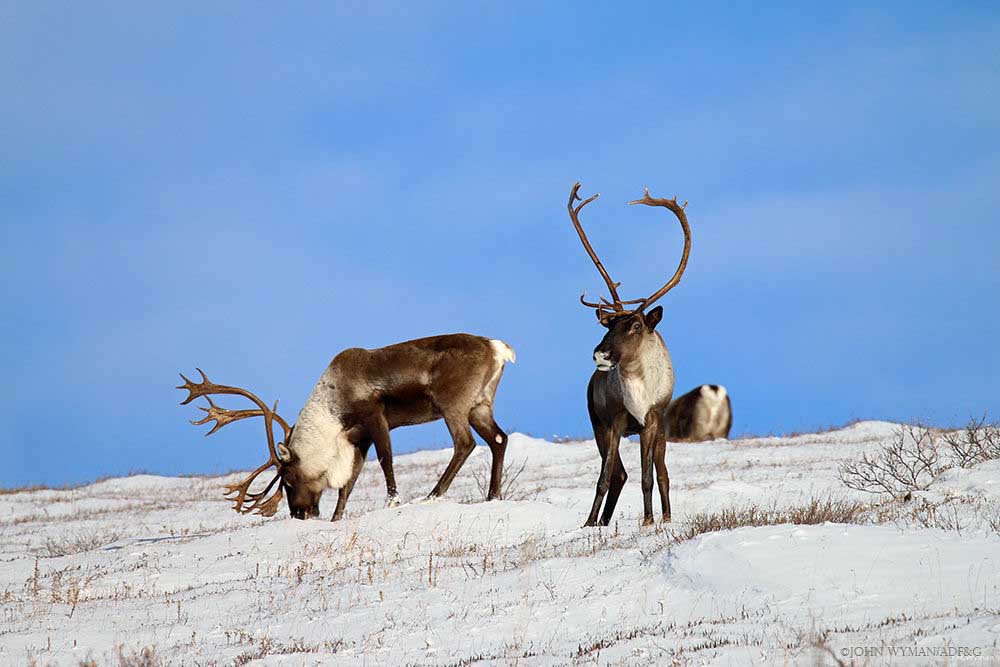Alaska’s Fortymile caribou herd numerous again
Published 8:46 am Thursday, August 24, 2017

- Caribou bulls are seen on a ridge close to an Alaska highway in 2016. (Submitted photo/Alaska Department of Fish and Game)
The Alaska Department of Fish and Game wants more time to determine whether its largest wolf control project is working.
Since 2005, state employees and private residents aboard airplanes or helicopters have killed more than 650 wolves on state lands east of Fairbanks with the goal of boosting the Fortymile caribou herd. It’s part of a state mandate codified in the 1994 Intensive Management Law to increase caribou and moose populations people rely on for food.
Not enough evidence exists to show 14 years of wolf control has helped the Fortymile herd, said Darren Bruning, who helps manage the Fortymile herd as regional supervisor for the Alaska Department of Fish and Game’s Divison of Wildlife Conservation.
The department plans to halt wolf control after one more season and see how the caribou respond to a least two years of uncontrolled predation, Bruning said. The temporary halt is part of the state’s wolf control study and is not a concession to wolf control opponents who say the program is ineffective or the Fortymile herd can’t get much bigger than its current population of about 50,000 animals.
“Wolf control is not being suspended because of a biological trigger or any new research findings,” Bruning said in an email this week. “Suspension of wolf control is just part of our adaptive management process to evaluate management actions and assess if they are contributing to meeting management goals.”
Important herd
Named for the Fortymile River north of Tok, the herd is an especially important herd for Interior hunters. Its migration route between the Taylor and Steese highways puts it within range of hunters who lack airplanes or riverboats. Its calving grounds are in the Tanana Hills in the upper Fortymile and Tanana river drainages.
Like other caribou herds, the Fortymile has a history of dramatic booms and busts. In the early 1920s, the herd was considered the largest caribou herd in the state, estimated at more than 568,000 animals, although population estimates from that long ago aren’t considered nearly as precise as today’s numbers. The population dropped dramatically between the mid-1960s and 1973, when it was estimated at an all-time low — not much more than one one-hundredth of its 1920s peak. At its nadir, the herd stood at between 5,700 and 8,600 animals.
The good news for caribou hunters is the herd has grown nearly every year for the past 50 years and now exceeds 50,000 animals. Hunters who faced heavy restrictions when the herd struggled have been able to harvest at least 1,000 caribou every year since 2011.
Whether predator control deserves credit for the growth of the Fortymile Herd and other caribou and moose populations is one of the most contentious debates in Alaska wildlife management.
Bruning sees the issue of the Fortymile wolf control as separate from the larger issue of predator control in general. In other parts of Alaska, studies show wolf control projects in Alaska definitely have increased prey populations, he said. But in the case of the Fortymile Herd, biologists need more data. In particular, biologists need more information on the weight of caribou calves and information about how they die, he said.
Before temporarily halting the program in 2018, department staff will do one more year of wolf control so seven years of data on “high intensity” wolf control (2012-18) can be compared with seven years of data on “low intensity” wolf control (2005-11), Bruning said.
“The pre-control information is becoming more and more distant in the past,” Bruning said. “By suspending operations, we can do evaluations during a time of no control.”
Intensive management
Public-funded shooting of wolves and bears by airplane to support moose and caribou populations dates back to 1948 in Alaska. Programs have come and gone with various state administrations. Older policies included using poisons and bounty systems to control predator numbers. The current predator control program for the Fortymile Herd began in 2005 and is the largest of four active wolf control programs. The other three are in remote parts of the western interior and southwest Alaska.
The Fortymile predator control area is about twice the size of New Jersey and covers most of the herd’s range within Alaska. Notably absent from the area is Yukon-Charley National Preserve, where federal land managers don’t allow wolf control.
The Fortymile wolf control program began with private residents who received special permits to shoot wolves from planes. In 2009, the program expanded to include state Fish and Game employees. Land-based hunters and trappers with conventional hunting and trapping licenses supplement the work of the aerial gunners and, as a group, often kill more wolves than the flying hunters.
In 2012, the department began attempting “high intensity” wolf removal, which has a goal of killing 75 percent of wolves in an area. The program has never reached this goal. Most years, the combination of hunters, trappers and aerial gunners kill fewer than 50 percent of the wolves in the Fortymile Herd wolf control area. Wolves travel long distances and can quickly recolonize areas after wolf control.






